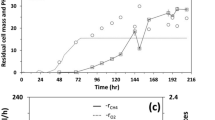Abstract
The results of this study indicate that an increase in CO2 percentage to 30% can enhance Scenedesmus sp. growth in autotrophic cultivation to a maximum of 0.85 g/l as compared with 0.6 g/l obtained in the batch with air (after 6 days of cultivation). However, while the CO2 was higher than 30%, it showed a negative impact on cell growth. A mixotrophic cultivation with 3 g/l of glycerol can achieve 0.38 g l−1 day−1 of the maximum biomass productivity compared with that of 0.21 g l−1 day−1 in autotrophic cultivation. Nevertheless, the lutein content of the mixotrophic cultivation was 0.08–0.1% lower than 0.2–0.25% obtained in autotrophic cultivation, which led to a lower lutein productivity of 0.36 mg l−1 day−1 in the mixotrophic batch compared with 0.44 mg l−1 day−1 obtained in the autotrophic batch. The limitation of cell growth in the mixotrophic cultivation would be the contributing factor regarding the lower lutein productivity. The mixotrophic cultivation of repeated batch to remove potential inhibitive metabolic products from glycerol catabolism does not show an obvious improvement on biomass. Conclusively, mixotrophic cultivation achieves higher biomass productivity with lower lutein content than that of autotrophic cultivation, which leads to lower lutein productivity. Therefore, the autotrophic cultivation is preferred in the lutein production.






Similar content being viewed by others
References
Fernández-Sevilla, J. M., Acién Fernández, F. G., & Molina Grima, E. (2010). Applied Microbiology and Biotechnology, 86, 27–40.
Ziegler, R., Colavito, E., Hartge, P., McAdams, M., Schoenberg, J., Mason, T., et al. (1996). Journal of the National Cancer Institute, 88, 612–615.
Piccaglia, R., Marotti, M., & Grandi, S. (1998). Industrial Crops and Products, 8, 45–51.
Del Campo, J. A., Rodríguez, H., Moreno, J., Vargas, M. A., Rivas, J., & Guerrero, M. G. (2001). Journal of Biotechnology, 85, 289–295.
Del Campo, J. A., Rodríguez, H., Moreno, J., Vargas, M. A., Rivas, J., & Guerrero, M. G. (2000). Journal of Biotechnology, 76, 51–59.
Shi, X. M., Zhang, X. W., & Chen, F. (2000). Enzyme and Microbial Technology, 27, 312–318.
Liang, Y., Sarkany, N., & Cui, Y. (2009). Biotechnology Letters, 31, 1043–1049.
Chojnacka, K., & Noworyta, A. (2004). Enzyme and Microbial Technology, 34, 461–465.
Cerón García, M. C., Sánchez Mirón, A., Fernández Sevilla, J. M., Molina Grima, E., & García Camacho, F. (2000). Journal of Applied Phycology, 12, 239–248.
Simons, K. (2008). Focus on catalyst 1–2.
Shi, X., Chen, F., Yuan, J., & Chen, H. (1997). Journal of Applied Phycology, 9, 445–450.
Zhu, M. M., Lawman, P. D., & Cameron, D. C. (2002). Biotechnology Progress, 18, 694–699.
Tukaj, Z., Matusiak-Mikulin, K., Lewandowska, J., & Szurkowski, J. (2003). Plant Physiology and Biochemistry, 41, 337–344.
Lee, Y. K., & Tay, H. S. (1991). Journal of Applied Phycology, 3, 95–101.
Sánchez, J. F., Fernández, J. M., Acién, F. G., Rueda, A., Pérez-Parra, J., & Molina, E. (2008). Process Biochemistry, 43, 398–405.
Benkortbi, O., Hanini, S., & Bentahar, F. (2007). Biochemical Engineering Journal, 36, 14–18.
Luedeking, R., & Piret, E. L. (1959). Journal of Biochemical and Microbiological Technology and Engineering, 1, 393–412.
Acknowledgments
The authors wish to thank the National Science Council of the R.O.C. for financial supports.
Author information
Authors and Affiliations
Corresponding author
Rights and permissions
About this article
Cite this article
Yen, HW., Sun, CH. & Ma, TW. The Comparison of Lutein Production by Scenesdesmus sp. in the Autotrophic and the Mixotrophic Cultivation. Appl Biochem Biotechnol 164, 353–361 (2011). https://doi.org/10.1007/s12010-010-9139-1
Received:
Accepted:
Published:
Issue Date:
DOI: https://doi.org/10.1007/s12010-010-9139-1




